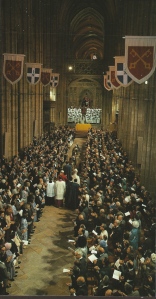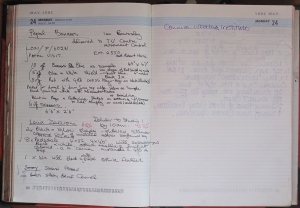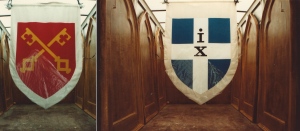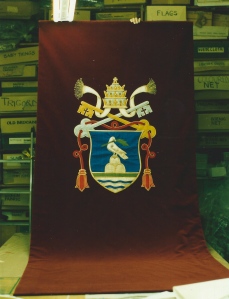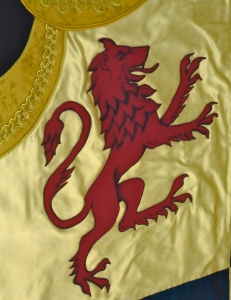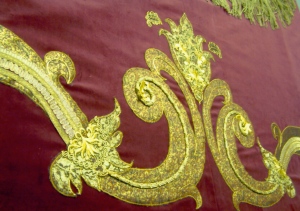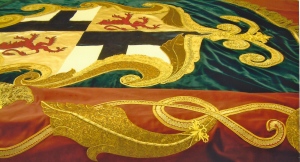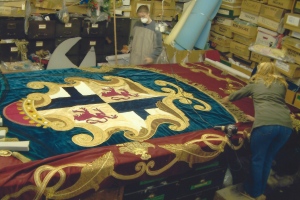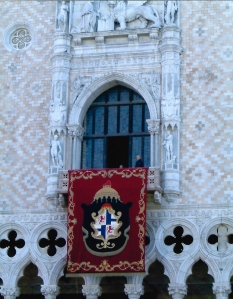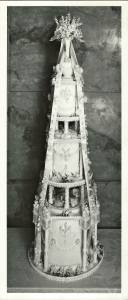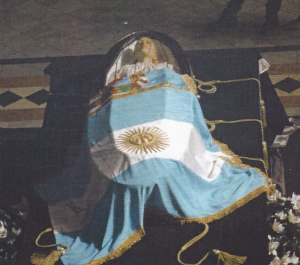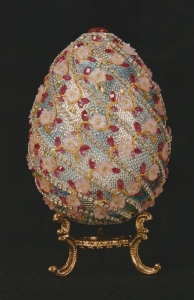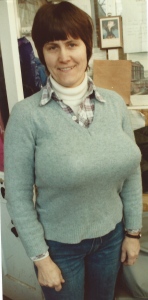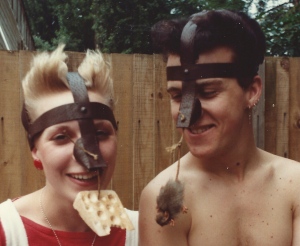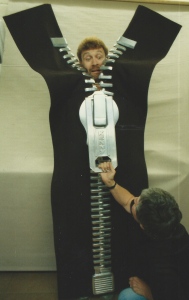 Louise writes – Although our work was primarily for Film and Television we were occasionally asked to supply items for real events. In May 1982 Pope John Paul ll, visited Canterbury Cathedral.
Louise writes – Although our work was primarily for Film and Television we were occasionally asked to supply items for real events. In May 1982 Pope John Paul ll, visited Canterbury Cathedral. 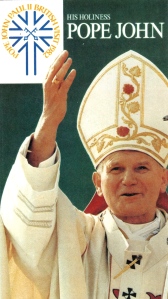 The BBC contacted us, at the last moment, to ask if we could make ten banners to hang in the roof of the aisle. The two designs featured the Pope’s Coat of Arms and Canterbury’s Coat of Arms. As there was no time or the budget to make anything elaborate, Dupion (an artificial slub silk) fabric was used for the background of the banners with details in felt and satin. These were glued in position; after all, they were only going to hang in the Cathedral for one or two days at most. Imagine our consternation when we discovered that, in fact, they were left in position for more than one year!
The BBC contacted us, at the last moment, to ask if we could make ten banners to hang in the roof of the aisle. The two designs featured the Pope’s Coat of Arms and Canterbury’s Coat of Arms. As there was no time or the budget to make anything elaborate, Dupion (an artificial slub silk) fabric was used for the background of the banners with details in felt and satin. These were glued in position; after all, they were only going to hang in the Cathedral for one or two days at most. Imagine our consternation when we discovered that, in fact, they were left in position for more than one year!
Keir and I went to Canterbury later in October 1982 and were relieved to see that the banners remained intact. Good old Evo-stik glue!
The second occasion we made a Pope’s banner was for the film ‘Evita’ for the scene where Eva Peron went on her ‘Rainbow Tour’ and had an audience with Pope Pius Xll. The banner was made of a dark red velvet with his Papal Coat of Arms emblazoned on the surface.
We made the various parts in satin or silk, which was then applied onto the velvet background. Details were painted in emulsion paint and gold powder mixed with PVA glue, thinned with water and for added depth we iced the Coat of Arms with a thicker mixture of PVA (wood glue) and gold powder. This was available in different shades of gold, copper and bronze colours. The gold was piped using a metal icing set with the smallest size circular nozzle. As long as the medium was mixed thoroughly with no lumps it was fine, but occasionally a blockage occurred and that led to almost ‘explosive’ results. When the line of icing dried it dipped in the centre and looked like gold Russia Braid. We also used ornate gold metallic decorations, and the finished result looked impressive but only took a relatively short time to create. It was never going to be seen in close up and it was a technique we used on many occasions over the years. The third Pope’s banner was for the 2005 film ‘Casanova’. It measured six metres high and four and a half metres wide, and was to hang from a balcony on the side of the Doges Palace in Venice – what a location. An A4 sized coloured drawing arrived from Anna Pinnock, the Set Decorator, at our Shepperton Studio workshop and I started to work out how we would make the banner, a daunting prospect, but one that I relished. The budget was £6000 and I had to purchase all the materials. Where to begin?
I decided to buy the fabrics, braids and fringing in London and went, driven by David our buyer. He could ‘hover’ if parking was impossible and help me with all the rolls of fabric and carrier bags and pay the bills. Our first call was to Joel and Son in Church Street NW8, one of my favourite fabric suppliers. There, one could purchase every type of fabric and I knew I would be successful in my search.
For the ornate scrolled border design I found an Indian gold and copper Lurex fabric. The design of the front was totally wrong – a woven paisley design – but I used the back of the material and the threads looked like long satin-stitched embroidery, a perfect illusion. Anna wanted velvet in a particular turquoise blue and amongst the swatches at Joel’s I found the perfect colour, but it had to be ordered, the supplier was an Italian company so it seemed rather strange to be ordering a velvet that had to come from Italy, only to make it up in England and return it to Venice once the banner was completed.
The next port of call was to Henry Newbery for braids and fringing. The fringe at the bottom of the banner was very long, about 15” (375mm) in-depth and there were other fringes and tassels in gold metallic thread, along with braid and cords. Silk, I obtained from a company called Pongees and finally the background of Venetian red I bought from John Lewis in Oxford Street. ‘Never knowingly undersold’ was their saying and true to the words the cotton velvet was by far the best price.
I decided to add two metres to the top of the banner just in case extra length was required and when it arrived on location – it was needed since they were not allowed to attach anything to the balcony itself. The extra fabric went over the edge of the balcony and down the back where it was secured by the weight of a plastic tube – see below. Everyone at the workshop who worked with fabrics and glue was involved with the banners manufacture – Carole, Christabel, Emma, George, June, Sally and me. Keir extended the largest table at the drapes end of the workshop but still the banner had to be manoeuvred from side to side and up and down. I was very concerned that after all our efforts the finished banner would arrive in Venice looking a creased mess, having travelled though Europe by road and been manhandled in the process.
We solved the problem by attaching heavy-duty eyelets on canvas webbing at the top and lashed it onto a plastic 10” (250mm) soil pipe. We then covered the decorative Coat of Arms with tissue paper, wadding and sheets of 1” (25mm) foam. The banner was loosely rolled up and wrapped in bubble film and polythene, what a performance, but well worthwhile, since I had a phone call from David Gropman, the Production Designer and Anna to say it had arrived safely and looked fabulous on the balcony. Thank goodness and what a relief! They even sent us a photograph to prove it.
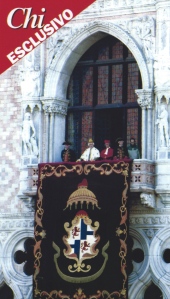
A photo from Chi magazine showing the ‘Casanova’ banner hung on the Doge’s Palace. Unfortunately the red has turned to black.
